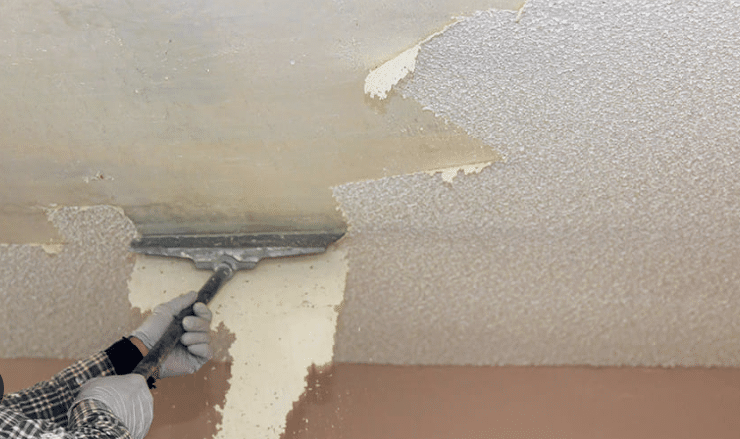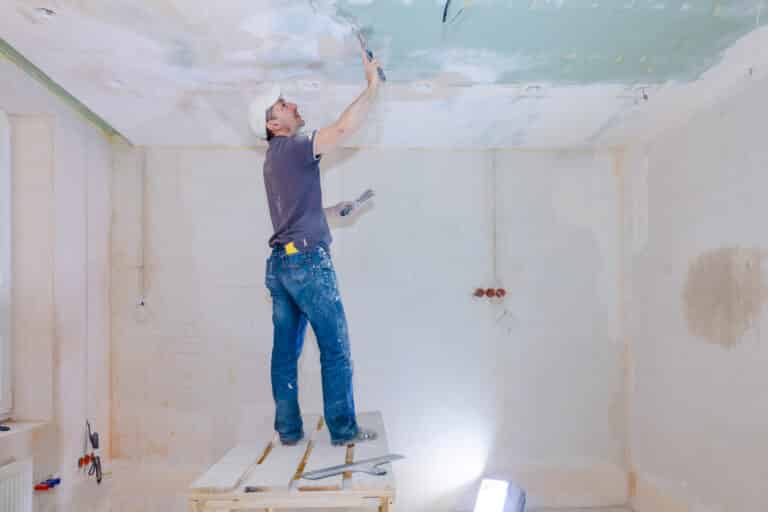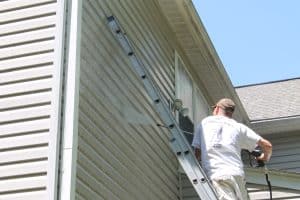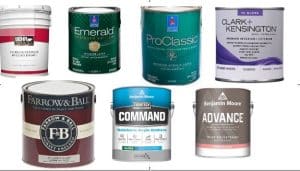
10 Essential Steps To Selling A House
What are the essential steps to selling a house in a changing market? According to Chad Kerr of Your Home Sold Guaranteed Realty – Kerr

Removing popcorn ceilings has become a typical project for painting companies. This texture has largely fallen out of favor today, and the procedure for removing a popcorn ceiling will be discussed here.
IMPORTANT! If the ceiling in question is in an older home where the popcorn between 1950 and 1985 may contain asbestos. Before Removing a Popcorn Ceiling, you must first test for asbestos. Home test kits for lead can be purchased online or at your local paint store for about $20. If your project ceiling contains asbestos, do not continue the removal process; contact an abatement professional to remove it.
The naked eye can not see asbestos. The particles are very small and light and stay airborne for up to four days. Even a tiny amount can cause serious health issues, including asbestosis, mesothelioma, and lung cancer.

As an alternative, the asbestos-containing popcorn is to cover it with a new layer of sheetrock to encapsulate it.
With no asbestos present, removing popcorn ceilings is a straightforward process. All you need is a pump sprayer with warm water and a scraper. It’s best to attach the scraper to a pole for easier reach. Protect the necessary surfaces and you are ready to start.
Just soak the popcorn or textured ceiling with water and let it soak in for about 15 minutes. Then, carefully remove the popcorn ceiling.
If the popcorn ceiling has been painted, then it may take longer for the water to soak in and loosen the bond.
If the popcorn has been previously painted over, removing a popcorn ceiling will still require some dry scraping, but since water will not help in the process, some serious sanding is now in order! Hand sanding with a sanding block might be done in a very small room, but investing in an electric pole sander with a vacuum attachment will make most jobs much easier and quicker! Home Depot has the proper sander for rent if you choose. The cost is about $55.00 a day or $210.00 a week. You want to ensure that the sander is connected to a vacuum cleaner and that you are still wearing a quality dust mask.
You might opt to purchase a Merka Leros if you are a contractor. It comes with a 9” sanding head and heap vac and retails for $2,200.00. It is an excellent piece of equipment that can pay for itself after a few good-sized jobs.
Festool is another outstanding company that makes three wall sanders, costing about the same amount of money as Merka Leros.
Regardless of which sanding tool you choose, you should start with 60-80 grit sandpaper and finish with 120 grit sandpaper.
If you are not sure how to remove your textured or popcorn ceiling, get a spray bottle of water and spray some on the ceiling. If it soaks in quickly, using the water and scraping method might be the best. However, if the ceiling is painted, sanding may be the better option.
If your popcorn contains no lead, you are ready to start the removal process.
First, could you remove any ceiling fixtures and fans? Tape and plastic walls/crown moldings around the perimeter of the room. Then, cover all furniture and floor areas; this is a messy job! Popcorn ceilings without paint are the easiest to remove. Just apply water and let it soak in and do the work.
Once the water is absorbed, take a large spackle knife and scrape off.
Start easy until you get the hand so as not to damage the drywall.
Remember, with a little caution, this process is quite manageable. You’ve got this!
After successfully removing the popcorn ceiling, it’s time to move on to the next step-spackling. Premixed spackle is a better choice than powder because it allows longer working and less clean-up time. For an added improvement in spreading the spackle, squirt about 1/3 of a cup of liquid detergent, such as Dawn Liquid Detergent, into a full spackle pan and mix it into the spackle. This simple trick makes spreading the spackle much easier and ensures a smooth finish.
Alternatively, you can use a combination of premixed spackle and a powder such as Easy Sand 45 to apply a second coat of spackle on the same day.
Spackle knife: Choose a high-quality 12” spackle knife when skimming the ceiling. The job will go much faster and look better.
Now that removing the popcorn ceiling is completed, it’s time for a primer coat. A primer coat often highlights minor imperfections that were not visible, requiring additional spackling. To make finding the areas easier, add colored chalk dust to the spackle. The spackle will have to be sanded before the final two topcoats.
For the best results, I suggest opting for an ultra-flat ceiling paint with a low sheen level. Avoid premium-grade flat paint as it can have a slightly higher sheen, which may enhance roller marks and imperfections, compromising the final look of your ceiling.
Once you are satisfied with the painting process, you can remove the tape and plastic from the walls. Hopefully, you used disposable plastic on the floor areas to catch all the popcorn mess and dust. That can now be gathered up and thrown away. Reinstall all ceiling fixtures and fans. The process of removing a popcorn ceiling is now complete!
Removing a popcorn ceiling without asbestos is easy. Sanding a textured ceiling is haarder and time-consuming. Spackling the ceiling to a smooth finish is a skill that some may find too difficult.
If you have not developed these skills, the expected time could be as much as 2-3 times longer than hiring a professional.
This work is an actual “pain in the neck.” All the work is above your head, and the less skill level you have, the longer it takes.
Popcorn generally comes off easier than a textured ceiling. Again, the number of coats and sheen on the ceiling will affect the time. The more coats and increased sheen will add to the time. In most cases, prep, removal, spackle, paint, and clean-up will cost around $2.50 per square foot for popcorn ceilings and $5.50 for textured ceilings painted with flat paint.
The prices are approximations. Ceilings with little texture and no paint could be as little as $2.00 a square foot, while heavily textured ceilings over 10’ high could be closer to $7.00 a square foot.
For a quote in your area please vsit us at Klappenberger & Son Find a location.

What are the essential steps to selling a house in a changing market? According to Chad Kerr of Your Home Sold Guaranteed Realty – Kerr

I want to share with you how to avoid common painting mistakes that most amateurs make and even some pros. I started Klappenberger & Son

When you want the highest sheen possible, you will want a high gloss or gloss paint. FYI, this is NOT what you typically put on

What is the best paint brand can be difficult when we have over 975 paint manufacturers making many paints. However, I have tested and used hundreds

There is fewer better ROI for a kitchen facelift than painting your kitchen cabinets. For most kitchens, the cabinets occupy most of the wall space.

The Ultimate Coverage Test Challange The Behr One Coat Coverage Guarantee states that if any of their 1,000 colors are applied, it will hide or
Klappenberger & Son, for more than 30 years, has been the leader in painting and handyman services across the Atlantic Seaboard. Now, through franchising, the company is steadily growing nationwide.
Klappenberger & Son offers a variety of services, including interior and exterior painting, staining, carpentry, historic preservation and more.
Klappenberger & Son franchisees strive to be transparent and provide clear communication throughout a project — from start to finish. Our team of highly trained and tested employees get the job done right the first time and every time.